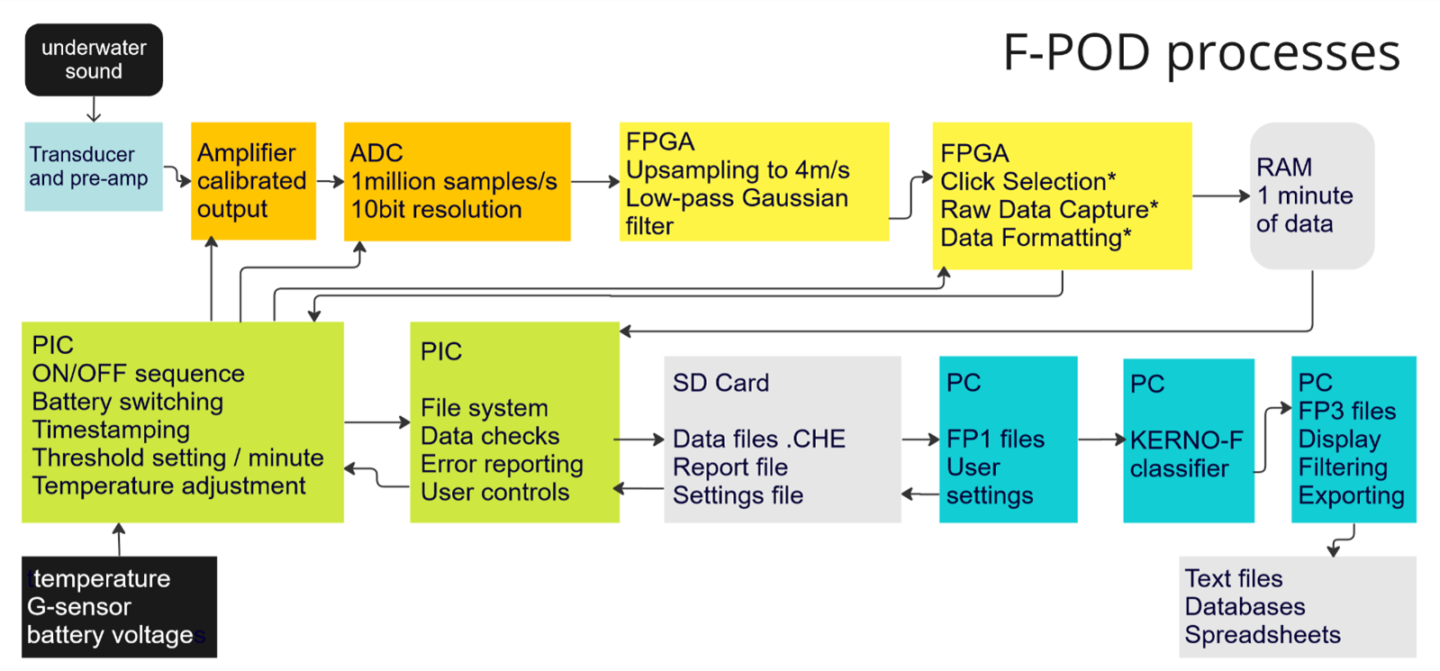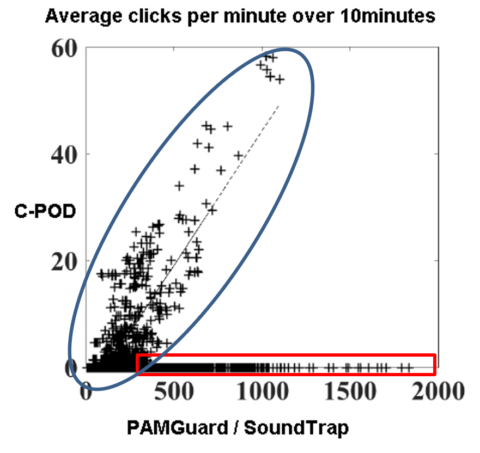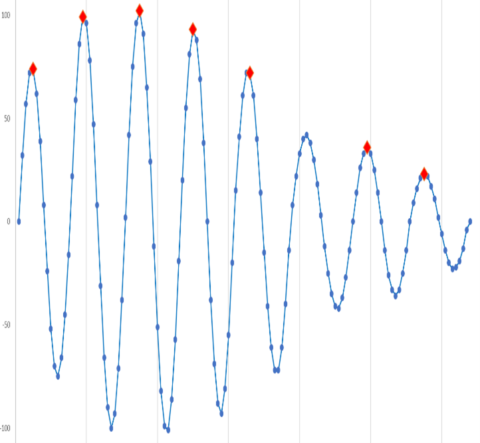How do F-PODs and conventional recorders compare?
- Conventional sound recorders provide useful data for sound level studies and capture dolphin whistles and baleen whale calls. F-PODs do none of those and the data does not allow the Fourier Transform to be used to determine the frequency spectrum of complex sounds.
- To collect the same cetacean click data as an F-POD, a conventional recorder must sample at approx. 500kHz, and use 16bit or larger values for each sample, so they require 1TB of memory every 10 days or less, which is 2,000 times as much memory as an F-POD requires. These huge data volumes are reduced by data compression but still force the use of intermittent logging by WAVE recorders, and require archiving that is not carbon neutral.
- F-POD cetacean click data does not suffer clipping when the sound is very loud – this is handled in real-time processing.
- F-PODs run for over 4 months continuously (or 8 months on lithium batteries) while conventional recorders sampling at 500kHz require more servicing visits due to battery or memory constraints. An F-POD can log alternate days for more than a year.
- The F-POD data is optimised for the process of cetacean click train detection that is carried out during post-processing on a PC by the KERNO-F classifier. This is fast, accurate, consistent and free. Methods used on conventional data can be very slow and subjective .
- The KERNO-F classifier also pulls out the click rates in fast click bursts that are used as social communication in many toothed cetaceans. This is proving to be of real biological significance.
- The F-POD records the temperature and its angle to vertical every minute.
- The F-POD housing is very robust and is externally simple so that bio-fouling can be removed easily.
- F-PODs are buoyant and marked with a web URL so many have been recovered having been lost and subsequently washed up on a distant shore.
- Data streaming and an integrated acoustic release are under development.
Here’s the pathway data, and settings, take through the system:

Conventional WAVE file recorders need to operate at 400kHz or above to record porpoises and they then typically record 1TB of data every 10days.
Such WAVE file data allows the use of the Fourier Transform (as FFT) to give frequency spectra. However very short sounds, like cetacean clicks, are not well suited to the FFT which also ‘loses’ half the information it receives. That data is not really lost, but is in a set of phase values that is of such limited practical use that it is rarely even mentioned. But it contains the information on when things happened in the click, i.e. the time domain.
The F-POD data is not suitable for FFT analysis, except in the case of the full waveform capture data.
Data from WAVE file instruments logging above 330kHz can be converted to ‘virtual F-POD files’ to get the advantages of data processing in the F-POD software. The classifier performance is then a long way below the normal performance on real F-POD data but can be useful.
F-POD features
F-PODs key features include: automation, long operation times, robustness, low false positive rates, high sensitivity and precise calibration. An F-POD:
- stores very high resolution (250ns) time-domain data on each click to enable powerful train detection and species classification, so the need for visual editing of data is generally removed, although some visual inspection of each data file is mandatory.
- detects and characterises short dolphin clicks more efficiently.
- has automated adaptation to noise so that it does not often max out, even in severe conditions.
- writes normal files to any micro SD card, up to 256 GB. 32GB is more than enough for a year of data.
- for sites with many sonars it can run two real-time sonar detectors that can filter out boat sonars, and record their detections.
- has a simple on-board train detection that selects some clicks from trains so that some representative full waveforms can be saved.
- has an extremely robust, sensitive, hydrophone.
- has a real-time clock which can be set by users, e.g. to local time rather than UTC.
- the standard F-POD takes primary lithium batteries without any modification.
- the rechargeable lithium version can run continuously for 8months +
- has a deep-sleep mode which enables the POD to run for years, sampling every nth minute.
- can be set to start at a later date to enable ‘daisy-chaining’ of instruments.
- can be set to switch on and off at different angles to the vertical.
Data differences
| Feature | F-POD | Wav file recorder |
|---|---|---|
| Data volume | Low. 120GB of F-POD data comprising 18years of continuous logging was collected in the early part of the BlackCeTrends project. It contained 400 million cetacean clicks. | High. A similar duration would require >600TB of data storage |
| Click detect only | Yes. This is the normal mode of operation. | Some have this feature with a variable approach that could impede future train detection. |
| Data format | Dedicated file structure that packages metadata with acoustic data to give fast and reliable data management in projects. .FP1 and .FP3 files. Open source formats. Code to unpack these formats is directly available from the FPOD.exe app. | Standard .wav file formats, sometimes via compressed formats. |
| Data features | Summary data on ultrasonic (>17 kHz) clicks and tones only. No data on dolphin whistles, etc | Frequency range defined by sampling rate and hydrophone. Generally, this will include lower frequencies than the F-PODs so will allow studies of dolphin whistles, broadband calls, low frequency calls, etc. |
| Full waveform capture. | A simple real-time train detection routine can trigger capture of up to 21 cycles of a click. This has provided the new insights on the frequency slopes of narrow-band-high-frequency clicks in 6 different species already. A waveform can be constructed from this for FTT analysis, but will only be representative for longer clicks such as NBHF clicks. | All clicks have the same sampling regime, which is ideal for spectral analysis using the FFT. |
| Noise monitoring | Not suitable, although some ultrasound noise indices are possible | Formal noise metrics usually possible. |
| Automated analysis method | Click train detection and classification processes within FPOD.exe software. No beam forming processes. | Click spectrum classification. PAMGUARD software provides coherent beam angle sequences from towed pairs of hydrophones which adds power to the classifier, and a user-configured train detection process. |
| Analysis strengths | Extensive experience in many countries of using this system has shown no major discrepancies from visual surveys where those are possible. Gives click rates in trains. This behavioural information is of value. False positive rates from pure automated analysis are low. In SAMBAH the combination of train classification and a previously developed Baltic data encounter classifier – ‘Hel1’ achieved a false positive rate of < 1 FP second per year. | Fits traditional spectral analysis approaches. |
| Analysis weaknesses | No logged information on low frequency sounds. | For NBHF species (porpoises and some dolphins) false positives from moving fine sand and other sources can be serious and may not be recognised by human analysts. For dolphins, spectral analysis resutls require human editing, which has a high time-cost, and requires quality control. |
| Analysis validation | Multiple published studies with visual observation have all showed good results | Very limited observational verification. |
| Analysis error messages | The automated analysis flags up error risks in the results from a file. | No warnings. |
| Temperature | Recorded every minute | No |
| Angle | Recorded every minute. Provides a measure or currents and identifies some deployment problems | No |
| False positve rate | Low. See PLOS ONE | Unknown |
| Sonar filtering | Yes. To control data volumes, two independent sonar filters can operate in each minute. | No. Data volume is unaffected by any sound sources. |
Hardware differences
| Feature | F-POD | WAV file recorder |
|---|---|---|
| Hydrophone | Hydrophone with characteristics similar to a B&K 8103 hydrophone. | See manufacturer’s website. |
| Calibration | Radial sensitivity at two frequencies for each instrument when made. | See manufacturer’s website. |
| Running time | 4-5 months on alkaline cells, or approx. 8 months + on lithium primary cells. The new rechargeable F-POD runs for 14 months when logging alternative minutes | Generally lower and limited by data storage requirements and batteries. Vary between devices. Part of minute only etc. from some systems. |
| Servicing interval | Determined by running time. | Determined by running time or memory size. |
| Robustness | Very high. Individual hydrophones have withstood being thrown against rocks many hundreds of times and shown no measurable change in calibration! C-PODs returned for calibration after 10years of continuous use are generally close to the standard, but sensitivities show a weak tendency to rise with age. | See manufacturer’s website. |
| Buoyancy | Positive. This facilitates deployment and recovery, especially when moorings are interfered with or lost – over 100 recoveries have been made via the http://www.phonehome.org.uk/ website. | See manufacturer’s website. |
Differences analysing POD and WAVE file data
| Feature | F-POD | WAV file recorder |
|---|---|---|
| Software | FPOD.exe handles data from the F-POD. It uses the KERNO-F classifier and displays, filters, analyses and exports the data. | Various: Raven, Pamguard, Ishmael, Audacity, Matlab, R etc. |
| Software cost | Free, including all upgrades | Various packages, some free. |
| Automated analysis speed | 1 day of data is usually analysed in 1 minute on a PC | Typically slower |
| Analysis time | Very low. Visual validation of a sample of data is required. If this passes, which is usual, the data can be used without further time costs. | Very high. Visual checking of all detections is commonly needed. |
| Project support | Free data quality reporting. Design discussion/advice. | See manufacturer's websites. |
| Empirical testing | Various papers have compared POD data with visual data. All have shown good agreement. | See manufacturer's websites. |

Comparing PODs to alternative instruments
Comparisons between different instruments are difficult because sensitivity can always be increased by accepting a greater rate or risk of false positives.
This outlines some of the issues and illustrates some of the errors made!
Updated: 2024

How the F-POD works
How the F-POD works.
The F-POD has two radical features – (1) the use of high-resolution time-domain processes to select clicks-of-interest in real time and store relevant detail at high precision.
(2) the KERNO-F classifier. Both are explained in this PowerPoint
Updated: December 2024